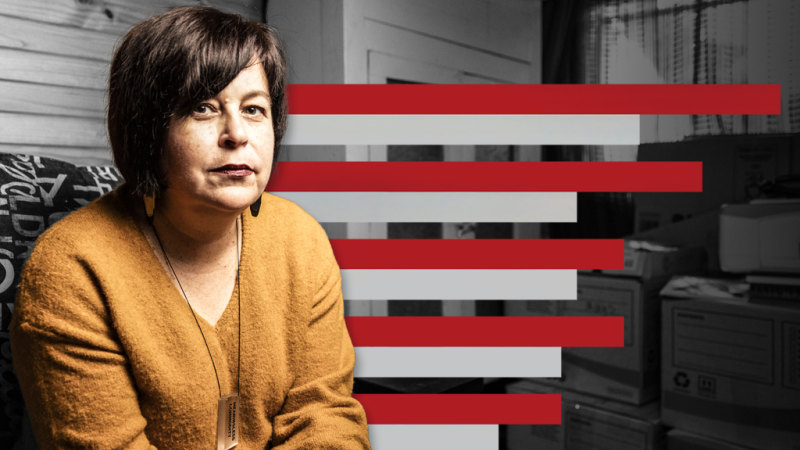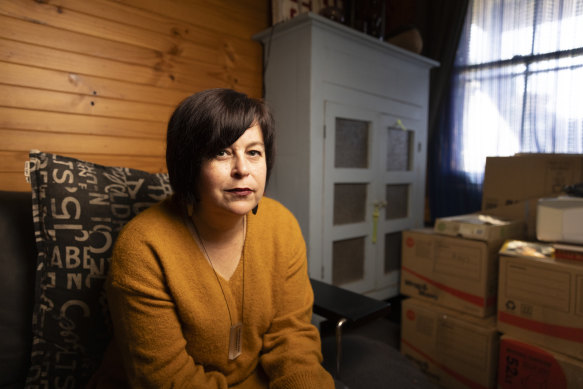Save articles for later
Add articles to your saved list and come back to them any time.
For Emma Warren, 47, the everyday costs continue to mount, but there’s nothing left in her budget to give.
“I don’t think many of my friends know how close I am to the edge financially,” she says. “I cried last night for a bit. Every now and then it just gets on top of you.”
Emma Warren is facing eviction as she is unable to cope with rising rent and rising living costs.Credit: Peter Stoop
Warren receives a government disability pension due to her ongoing battle with Crohn’s disease, depression and anxiety. A photographer, her ability to work is dependent on her fluctuating health.
In December, her landlord hiked the rent on her one-bedroom Newcastle apartment by 15 per cent. She’s since cut back on medical and counselling appointments, turned off the heating and has begun selling off her belongings to pay for day-to-day items.
Gone are any social activities she used to enjoy with friends, something she describes as being like an “invisible lockdown”.
After 10 years in her rental, she needs to find a new place to live after being hit with a no-grounds eviction notice. There’s nothing in her area within her price range.
“I can’t find any more money,” she says.
Warren’s plight is a microcosm of the situation facing many households across the state, according to the NSW Council of Social Service Cost of Living 2023 research. It found dual housing and energy crises were cutting deep into budgets, forcing families to sacrifice essentials to survive.
Undertaken by the University of Technology Sydney, the survey of 1134 people living below the poverty line and in low-income households across NSW illustrates the struggles many face on a day-to-day basis.
The report found more than 70 per cent of respondents experiences housing stress, defined as spending more than 30 per cent of their income on housing; while nearly 80 per cent of low-income households said utility bills were the expenditure putting their budgets under the most strain.
Titled Barely hanging on: The Cost-of-Living Crisis in NSW, the report reveals household emergency funds have been eaten away by rampant inflation, particularly the rising cost of power bills, with almost two-thirds of respondents now having no money set aside.
For those with emergency savings, the average amount had halved in just 12 months, falling from $9137 last year, to $4050 in 2023.
The precarious financial situation of many households was being exacerbated by buy now, pay later services, with more than a quarter of respondents using the service three or more times to pay for essentials in the last year.
Almost 40 per cent had pawned or sold something because they needed cash.
NCOSS chief executive Joanna Quilty said the survey highlighted the “drastic measures” households were taking to stay afloat, including forgoing food, prescribed medication and hygiene goods to counteract rising living costs.
“Housing stress is at an all-time high. We know it’s bad, but it keeps getting worse. It doesn’t seem to hit a ceiling,” she says.
NSW Council of Social Service chief executive Joanna Quilty says many households were taking “drastic measures” to survive the cost of living crisis
“What came through from the focus groups was the distress, anguish and the pressure on families, and I think many are at breaking point.”
The financial stressors caused by inflation, which reached 7.8 per cent in the December quarter, were underlined by the jump in people’s inability to pay bills and essentials.
While 45 per cent of respondents said they had received a pay rise in the past 12 months, only 9 per cent said the increase had been sufficient to cover their increased costs.
A third of households surveyed could not pay utility bills on time, an increase from 24 per cent in 2022; while 28 per cent of respondents said they could not afford to travel for essential reasons.
While the pain was shared across NSW, rising utility bills were disproportionately hitting the regions, with over a third of households in Riverina, Murray and Central West ranking these as their number one expenditure under the most pressure.
The report noted the “prevalence of extreme housing stress is rife”, pointing to the seven areas of Sydney where more than a third of households are spending 50 per cent or more of their income on housing.
Almost one in five respondents said they were failing to pay their housing costs on time, a 27 per cent year-on-year jump since 2022. The onset of the housing crisis saw 14 per cent of respondents forced to move due to cost. That figure jumped to 18 per cent for renters.
While noting the state government can do little in the short term to resolve the cost-of-living crisis, the report presented nine recommendations to help alleviate the worst impacts.
It called for permanently increasing the value of Energy Accounts Payment Assistance vouchers to $2000, while allowing for the entire amount to be used for any energy type. Moreover, simplifying the application and approval process for available governmental rebates and vouchers.
With boxes of her belongings stacked up around her, Warren is worried if she can’t find a place within her budget, she will be forced to move into a friend’s garage.
“I’m finding it really tough to have positivity as I look towards the rest of the year. I’m finding it tough to feel hope. Governments just aren’t listening,” she said.
“I don’t need to hear your five-10 year plan on housing. What are you doing now?”
Energy Minister Penny Sharpe said the government was looking at providing rebates to help struggling households.
“The NSW Labor government takes the issue of support for low-income families very seriously. Energy rebates for about 1.6 million households are being rolled out.”
The Morning Edition newsletter is our guide to the day’s most important and interesting stories, analysis and insights. Sign up here.
Most Viewed in Politics
From our partners
Source: Read Full Article




